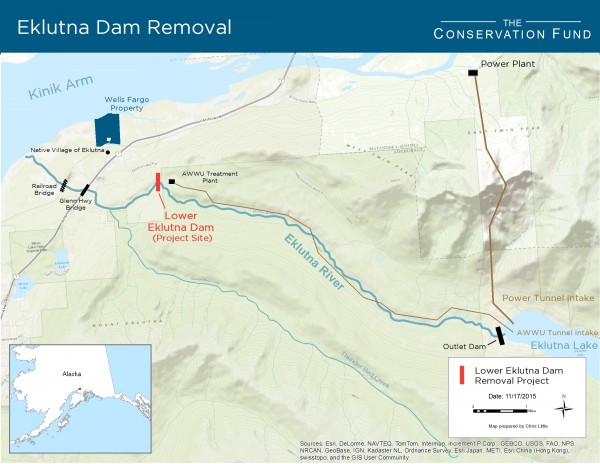An old dam on the Eklutna River has blocked salmon runs there for decades. Now, an Alaska Native tribe wants to tear the dam down and restore fish to the river.

It stands in a canyon 400 feet deep, a mile or so off the Glenn Highway, but hidden from the view of passing motorists. The old Eklutna Dam was built in 1929, to divert Eklutna River water for Anchorage hydroelectric power. It operated for only thirty years, before Eklutna Lake water, the source of the river, was diverted elsewhere for another hydro project. For half a century, the dam has been obsolete, as far as power is concerned, but it is still blocking salmon runs.
“It’s completely backfilled with sediment, it’s about 61 feet tall and maybe 100 feet wide. And it’s blocking fish passage into the Eklutna River. There are five species of salmon that spawn in the lower reaches of the river, but they can’t get past the dam.”
Brad Meiklejohn is the Alaska director for the Conservation Fund. He says the idea was inspired by the 2014 documentary film, “Dam Nation.” Micklejohn says the old dam has to go, so that salmon runs can be restored to the the river.
The Conservation Fund has pledged to pay the cost of the project,and the local Alaska Native corporation, Ekluna, Inc., is on board with the plan.
Curtis McQueen, CEO of Eklutna Inc, says it’s been a dream of his for years to see the dam removed. He says it will “lift the spirit of the village,” and that spirit is intertwined with salmon.
“We have a few elders that are in their late 80s, and 90s, that as children, remember where they would race out of their house, literally to the Eklutna River, which was a raging river, and they were fed. So all summer long until late in the fall, they could count on their subsistence right in their backyard.”
But over the decades, railroad and highway projects have altered the river bed radically, essentially devastating the lower river near the village. A U.S. Army Corps of Engineers study done [2011 -2012] a couple of years ago confirmed the problem, but indicated mitigation is possible. McQueen says pools could be created in the riverbed for salmon fry to hide in, or riverbank restoration projects could provide protection for small fish. But a greater problem needs to be addressed, he says.
“Between the deep water and the protection, you might be able to improve the bottom, but that isn’t going to solve the big picture. And the big picture is, someday, getting more water down the watershed.”
Since regular maintenance on the dam ceased decades ago, debris, boulders and silt have built up behind it. That will have to be removed, but Brad Mieklejohn says taking the old dam out is the easier of the two-part plan. The second part… the task of getting more water back into the Eklutna River…will be the “hard part,” he says.
The Eklultna River is pretty much devoid of water these days, because a second dam at its headwaters at Eklutna Lake diverts water to the hydropower station on the Knik River, where the water is dumped into the Knik.
That power plant was build under a federal program, then signed over to a consortium of Chugach Electric, Matanuska Electric Association and Muni Light and Power during the 1990s. The companies own the water rights to Eklutna Lake. Meiklejohn says a 1991 federal agreement requiring habitat mitigation could be a tool to pry at least some of that water loose. He recently told an audience at Palmer’s Salmon Symposium
“And we are calling on all the parties that signed this agreement to open it up, start talking about mitigation. Our view is, you break it, you fix it. You take all the water out of a river, it’s a pretty clear impact, it’s pretty easy to define. ”
Phil Steyer, spokesman for Chugach Electric, says his company as yet has no information on the plan, and cannot comment yet.
McQueen says Eklutna has a good relationship with all three companies, and points out that MEA built its newest power facility on Eklutna land.
“What we’d like to do is at some point in the future, is to have those conversations with the utilities, and ask their help, in finding a balance where they still have the hydro needs that they want… they still can generate the revenue off selling water, that they want. The question is, can some of that lake water be released, or redirected back. ”
Meilkejohn says those conversations have yet to take place. And he says no one knows how much water is needed to restore salmon habitat.
At this time, McQueen says, Eklutna Inc is focusing on removal of the old dam. Work is scheduled to begin next year, and it is hoped the village will be celebrating the dam’s demise by 2018.
APTI Reporter-Producer Ellen Lockyer started her radio career in the late 1980s, after a stint at bush Alaska weekly newspapers, the Copper Valley Views and the Cordova Times. When the Exxon Valdez ran aground in Prince William Sound, Valdez Public Radio station KCHU needed a reporter, and Ellen picked up the microphone.
Since then, she has literally traveled the length of the state, from Attu to Eagle and from Barrow to Juneau, covering Alaska stories on the ground for the AK show, Alaska News Nightly, the Alaska Morning News and for Anchorage public radio station, KSKA
elockyer (at) alaskapublic (dot) org | 907.550.8446 | About Ellen




